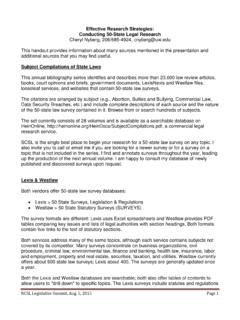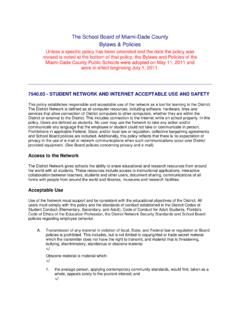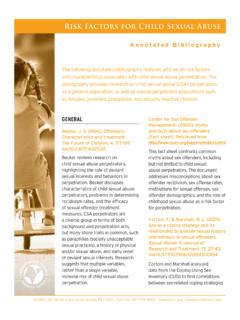Transcription of Validated Measurement Tools & Evidence Based Programs
1 Validated Measurement Tools &. Evidence Based Programs _____. The following are Measurement Tools and Evidence - Based Programs that have been Validated by outside research . This is not meant to be an exhaustive list. It is designed to give you a starting point and some options when creating a plan to measure your work. The MetroWest Health Foundation does not endorse the use of one tool or program/method over another. It is up to you to decide which Tools and methods are best for your program. General Program Planning and Evaluation Resources Centers for Disease Control Framework for Program Evaluation (overview of public health evaluation methodology): Re-Aim Framework (framework for planning, implementing and evaluating public health Programs ): Kellogg Foundation Logic Model Development Guide (framework for developing program logic models): The Logic Behind Logic Models (Healthcare Georgia Foundation framework for logic model development): Healthy Aging General Resources National Council on Health Aging: Center for Healthy Aging (lists of Evidence - Based Programs and how to access them).
2 LGBT Aging Project (resources, information, and programming focused on aging in the LGBT community): Stanford School of Medicine Patient Education (numerous Evidence - Based assessment Tools ): Re-Aim Framework applied to physical activity Programs for older adults: Caregiver Support Measurement Tools tool What it How it is Administered How to Access Measures Zarit Burden Caregiver Stress Caregiver completes Description of Scale: Interview settings/assessment/ Complete Scale: %20 Support%20-%20 The%20 Zarit%20 Burden% SF-12 Perceived Caregiver completes or Description of Scale: health status professional interview 12v2 HealthSurvey/tabid/186 *There is a fee associated with this scale Patient Depression Caregiver completes Complete Scale: Health symptoms 9 Questionnaire Description and reliability/validity information: Revised Observed Caregiver completes Description of Scale: Memory and behavior Behavior problems in settings/assessment/ Checklist patients with Complete Scale: dementia and perceived caregiver burden or distress Caregiver Stress levels of Caregiver completes Description of Scale: Self- caregivers Assessment settings/assessment/ Questionnaire Complete Scale.
3 Content/uploads/2010/11 Caregiver Support Evidence - Based Practices and Resources American Psychological Association (Caregiver assessment Tools and best practices in intervention): Family Caregiver Alliance: Selected Caregiver Assessment Measures (a description of many other Measurement Tools ): Assuring Healthy Caregivers (CDC): The Re-Aim Framework: New York University Caregiver Intervention (designed for spouse caregivers): Powerful Tools for Caregivers (6 session course focusing on caregiver self-care and communication): Stress Busting Program for Family Caregivers (9 week program designed for caregivers of those with Alzheimer's disease and dementia): Savvy Caregiver Program (12 week course for caregivers of those with Alzheimer's disease): Social Isolation Measurement Tools tool What it How it is Administered How to Access Measures De Jong Perceived Consumer fills out; via phone.
4 Validation research and survey questions: Gierveld loneliness or via personal interview ~gierv005 Loneliness Scale Lubben Size of Consumer fills out Description of scale and links to complete scale: Social social Network network Scale and perceived support Multi- Perceived Consumer fills or via Information: dimensional social telephone Scale of support Perceived Complete Scale: Social Support UCLA Perceived Consumer fills out Validation Study: Loneliness social Sale support Complete Scale: sures/Self_Measures_for_Loneliness_and_I nterpersonal_Problems_V. Social Isolation Prevention Resources AARP Framework for Isolation in Adults Over 50: Chronic Disease Management and Wellness Measurement Tools tool What it How it is Administered How to Access Measures Mini Presence of Self-report or caregiver Description and scale: Nutritional malnutrition completes Assessment in seniors Patient Quality of Patient completes Description and scale: Assessment care of of Care for patients with =36.
5 Chronic chronic Conditions disease (PACIC) receive Survey Assessment Level of Medical professionals Description and scale: of Primary support for Care self- Resources management and Supports of chronic for Chronic disease in Disease Self- primary care Management (PCRS). Chronic Patient Patient completes Scale and links to validation data: Disease Self- confidence in Efficacy Scale managing their disease Rapid Physical Consumer completes or Description and Scale (the scale is free to use but you need to register Assessment activity levels telephone interview on the site): of Physical in older (different version of scale). Activity adults (RAPA). Chronic Disease and Wellness Evidence - Based Programs and Resources *Most of these Programs have Measurement Tools as part of them My Life, My Health (chronic disease self-management program): Healthy Eating for Successful Living in Older Adults (education course to improve knowledge of nutrition and exercise): Walk with Ease (Arthritis Foundation program that promotes walking and exercise): Healthy IDEAS (integrates depression screening and management into existing case managements services): A Matter of Balance (fall prevention workshop): Enhance Fitness (exercise program for older adults): Stanford University Chronic Disease Self-Management Program.
6 BRITE-Brief Intervention and Treatment for Elders (Substance use screening and brief intervention): Community Healthy Activity Program for Seniors CHAMPS (physical activity program for seniors): Access to Care tool What it How it is Administered How to Access Measures Behavioral A number of CDC administers via Massachusetts results available at (search for BRFSS). Risk Factor health telephone to a random Surveillance indicators sample A Profile of Health Among Massachusetts Adults, 2011 (summary of System including 2011 results): (BRFSS) insurance Survey enrollment and primary care visits Evidence - Based Resources Health Literacy Universal Precautions Toolkit (guide on how practitioners can improve patient health literacy): Agency for Health Care research and Quality ( Dept.)
7 Of Human Service site-various Tools and fact sheets): Adolescent Mental Health Resources SAMHSA's National Registry of Evidence - Based Programs (list of Evidence - Based mental health Programs ): Mass General Hospital School of Psychiatry (list of Tools that measure individual level mental health issues): Bright Futures at Georgetown University (various Tools and resources on child and youth mental health): Maine Health (various adolescent mental health assessment Tools ): National Assembly on School Based Health Care (list of organizational assessment Tools for capacity building around mental health): tool What it How it is Administered How to Access Measures MetroWest A number Middle and High School Results can be found under the Adolescent Health Tab at: Adolescent of health students complete the Health Survey indicators, survey in school every 2 including years mental health Center for Depression Youth completes Survey: Epidemiological symptoms Studies Depression Description: Scale for Children #CES-DC.
8 Patient Health Presence & Youth completes Survey: Questionnaire severity of (PHQ-9) depression CRAFFT Alcohol Youth completes Survey: Adolescent and/or Alcohol/ substance Substance abuse Abuse Screening CDC's A number Different Tools are Surveys and background: Measuring of Tools administered differently- Bullying that most are completed by Victimization, measure youth Perpetration frequency and Bystander and type of Experiences bullying Evidence - Based Programs and Resources: Bullying Prevention Second Step Curriculum (violence prevention curriculum for k-8th grade students): Steps to Respect (school-wide approach to bullying prevention): Stop Bullying. Gov (resource for curriculum and information on bullying prevention): Evidence - Based Programs : Mental and Social-emotional Health Brookline Resilient Youth Team (program for high school youth re-entering school after psychiatric hospitalizations): Open Circle (classroom curriculum led by teachers designed to give children (k-5) skills in managing emotions, building positive relationships, and handling challenging social situations): Signs of Suicide (program for middle and high school youth that shows them how to identify symptoms of depression and suicide in themselves and friends).
9 Positive Behavioral Intervention and Supports-PBIS (school-level intervention that promotes positive behavior instead of reacting to negative behavior-it has three tiers of intervention-universal; at-risk students; high needs students).







